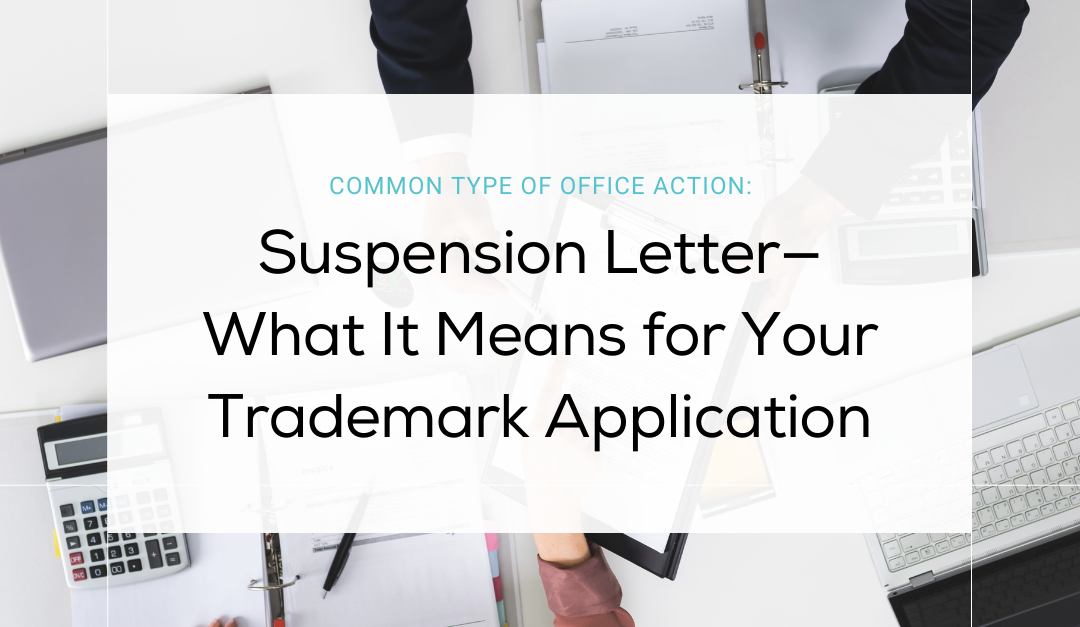Navigating the trademark application process can often feel like a series of hurdles, with various steps that may require attention and action. One of the communications you may receive from the United States Patent and Trademark Office (USPTO) is a Suspension Letter. While receiving this letter might sound alarming, it’s important to understand that it’s a normal part of the process in certain situations and doesn’t necessarily mean there’s a problem with your application. In fact, a Suspension Letter is simply a notice that your application is temporarily on hold while waiting for an external issue to be resolved.
In this blog post, we will explore what a Suspension Letter means, why it’s issued, and what steps you can take to ensure your application remains on track.
What Is a Suspension Letter?
A Suspension Letter from the USPTO informs you that your trademark application has been temporarily paused, or “suspended,” while the examining attorney waits for an external condition to be met. The suspension typically occurs when the outcome of your application is dependent on something outside of the USPTO’s control.
There are several reasons why your trademark application might be placed on hold, including:
- Pending Third-Party Trademark Applications: If there is a pending trademark application that is similar to yours and could affect your registration, your application may be suspended until the earlier application is resolved. This could involve waiting for the third-party application to either be approved or denied.
- Foreign Registrations: If your application relies on a foreign trademark registration, the USPTO will suspend your application until the foreign registration is officially granted.
- Ownership Issues: If there’s a pending ownership assignment or transfer for the trademark in question, the USPTO may place your application on hold until the ownership issue is resolved.
The Suspension Letter is not a request for additional information or clarification, so it doesn’t require you to take immediate action. However, being proactive and staying informed during the suspension period can help you better manage your trademark application.
Why Was My Application Suspended?
Receiving a Suspension Letter can be frustrating, but it’s important to recognize that this pause in the process is usually due to external factors. Here are some common reasons why your trademark application might be suspended:
- Conflicting Pending Applications
One of the most frequent reasons for suspension is the presence of a conflicting trademark application that was filed before yours. The USPTO examines applications in the order they are filed, so if someone else has applied for a trademark that is too similar to yours, the USPTO will wait until that earlier application is resolved before making a decision on yours. This process ensures that there are no conflicting registrations in the marketplace.
- International or Foreign Trademark Filings
If your application is based on a foreign trademark registration under Section 44(e) or the Madrid Protocol, your U.S. application may be suspended until the foreign registration is finalized. The USPTO cannot grant a trademark in the U.S. based on a foreign registration until that foreign registration is official. This is common for applicants who are expanding their business internationally and want to protect their trademarks across multiple jurisdictions.
- Ownership Issues or Legal Proceedings
Trademark ownership can be transferred or assigned to another entity, but if there’s any uncertainty or a pending legal proceeding regarding ownership, the USPTO may suspend your application until the matter is resolved. The same applies if your trademark is involved in an opposition or cancellation proceeding in the Trademark Trial and Appeal Board (TTAB).
What Should You Do When You Receive a Suspension Letter?
Although a Suspension Letter doesn’t require an immediate response, it’s important to understand what steps you can take to ensure your application progresses smoothly:
- Monitor Your Application’s Status
Just because your application has been suspended doesn’t mean you should ignore it. The USPTO reviews suspended applications every six months to check whether the reason for suspension has been resolved. You can log into the USPTO’s Trademark Status and Document Retrieval (TSDR) system at any time to check on the status of your application. If the external factor that caused the suspension has been resolved, the suspension may be lifted, allowing your application to proceed.
- Notify the USPTO if Necessary
In some cases, you may be able to provide additional information or notify the examining attorney that the reason for suspension has been resolved. For example, if the third-party application that was blocking your trademark has been denied, you may want to reach out to the USPTO to inform them and request that the suspension be lifted.
However, it’s important to remember that not all suspensions require this kind of action. In many cases, the suspension will be lifted automatically once the external issue is resolved. Nonetheless, keeping communication lines open with your trademark attorney and the USPTO can help expedite the process when appropriate.
- Consult With Your Attorney
If you’re unsure why your application has been suspended or what steps to take next, consulting with your trademark attorney is a wise move. Your attorney can explain the specific reasons for the suspension and advise you on the best course of action. In some cases, they may be able to contact the USPTO to provide additional information or clarification, which could help move your application forward.
Is a Suspension Letter a Setback?
It’s natural to feel concerned when you receive a Suspension Letter, especially if you were hoping to secure your trademark registration quickly. However, it’s important to remember that a suspension is not necessarily a setback. Instead, it’s simply a pause in the process to allow an external factor—such as a third-party application, foreign registration, or ownership issue—to be resolved.
In fact, a suspension can sometimes work in your favor by giving you more time to address any outstanding issues with your trademark or business operations. While your application is suspended, you can still continue using your trademark in commerce, and you retain the priority date from when you initially filed your application. Once the external issue is resolved, your application will proceed, and the USPTO will continue its examination.
Conclusion
Receiving a Suspension Letter as part of your trademark application process doesn’t need to cause alarm. It simply means that the USPTO is waiting for an external factor to be resolved before moving forward with your application. By monitoring the status of your application and staying informed about any developments, you can ensure that the suspension doesn’t lead to unnecessary delays.
Keep in mind that suspensions are reviewed every six months, and you can always reach out to the USPTO or your attorney if you have any questions or if the reason for the suspension has been resolved. The key to a successful trademark application is patience and communication, and a Suspension Letter is just another step along the path to protecting your brand.
If you’ve received a Suspension Letter or have any questions about the trademark process, feel free to contact our experienced legal team at Lengea Law for assistance. We’re here to help you navigate the complexities of trademark law and keep your application on track for approval.


